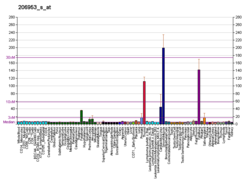A latrotoxin is a high-molecular mass neurotoxin found in the venom of spiders of the genus Latrodectus as well as at least one species of another genus in the same family, Steatoda nobilis. Latrotoxins are the main active components of the venom and are responsible for the symptoms of latrodectism.

ADGRV1, also known as G protein-coupled receptor 98 (GPR98) or Very Large G-protein coupled receptor 1 (VLGR1), is a protein that in humans is encoded by the GPR98 gene. Several alternatively spliced transcripts have been described.

Brain-specific angiogenesis inhibitor 2 is a protein that in humans is encoded by the BAI2 gene. It is a member of the adhesion-GPCR family of receptors.

Cadherin EGF LAG seven-pass G-type receptor 3 is a protein that in humans is encoded by the CELSR3 gene.

Latrophilin 1 is a protein that in humans is encoded by the ADGRL1 gene. It is a member of the adhesion-GPCR family of receptors. Family members are characterized by an extended extracellular region with a variable number of protein domains coupled to a TM7 domain via a domain known as the GPCR-Autoproteolysis INducing (GAIN) domain.

Latrophilin 3 is a protein that in humans is encoded by the ADGRL3 gene.

G protein-coupled receptor 126 also known as VIGR and DREG is a protein encoded by the ADGRG6 gene. GPR126 is a member of the adhesion GPCR family. Adhesion GPCRs are characterized by an extended extracellular region often possessing N-terminal protein modules that is linked to a TM7 region via a domain known as the GPCR-Autoproteolysis INducing (GAIN) domain.

Probable G-protein coupled receptor 123 is a protein that in humans is encoded by the GPR123 gene. It is a member of the adhesion-GPCR family of receptors. Family members are normally characterized by an extended extracellular region with a variable number of protein domains coupled to a TM7 domain via a domain known as the GPCR-Autoproteolysis INducing (GAIN) domain.

G protein-coupled receptor 112 is a protein encoded by the ADGRG4 gene. GPR112 is a member of the adhesion GPCR family. Adhesion GPCRs are characterized by an extended extracellular region often possessing N-terminal protein modules that is linked to a TM7 region via a domain known as the GPCR-Autoproteolysis INducing (GAIN) domain.

Adhesion G-protein coupled receptor A3 (ADGRA3), also known as GPR125, is an adhesion GPCR that in humans is encoded by the Adgra3 gene.

G protein-coupled receptor 114 is a protein encoded by the ADGRG5 gene. GPR114 is a member of the adhesion GPCR family. Adhesion GPCRs are characterized by an extended extracellular region often possessing N-terminal protein modules that is linked to a TM7 region via a domain known as the GPCR-Autoproteolysis INducing (GAIN) domain.

Probable G-protein coupled receptor 110 is a protein that in humans is encoded by the GPR110 gene. This gene encodes a member of the adhesion-GPCR receptor family. Family members are characterized by an extended extracellular region with a variable number of N-terminal protein modules coupled to a TM7 region via a domain known as the GPCR-Autoproteolysis INducing (GAIN) domain.

Probable G-protein coupled receptor 133 is a protein that in humans is encoded by the GPR133 gene.

Probable G-protein coupled receptor 144 is a protein that in humans is encoded by the GPR144 gene. This gene encodes a member of the adhesion-GPCR family of receptors. Family members are characterised by an extended extracellular region with a variable number of protein domains coupled to a TM7 domain via a domain known as the GPCR-Autoproteolysis INducing (GAIN) domain.

EGF, latrophilin and seven transmembrane domain-containing protein 1 is a latrophilin-like orphan receptor of the adhesion G protein-coupled receptor family. In humans this protein is encoded by the ELTD1 gene. ELTD1 appears to have a role in angiogenesis, both physiological and pathological in cancer.

Neuronal acetylcholine receptor subunit alpha-4, also known as nAChRα4, is a protein that in humans is encoded by the CHRNA4 gene. The protein encoded by this gene is a subunit of certain nicotinic acetylcholine receptors (nAChR). Alpha4-containing nAChRs appear to play a crucial role in the addictive response to nicotine..

Olfactory receptor 2H2 is a protein that in humans is encoded by the OR2H2 gene.

Olfactory receptor 2M4 is a protein that in humans is encoded by the OR2M4 gene.

Olfactory receptor 13C4 is a protein that in humans is encoded by the OR13C4 gene.

Olfactory receptor 9Q1 is a protein that in humans is encoded by the OR9Q1 gene.


















